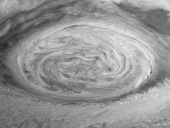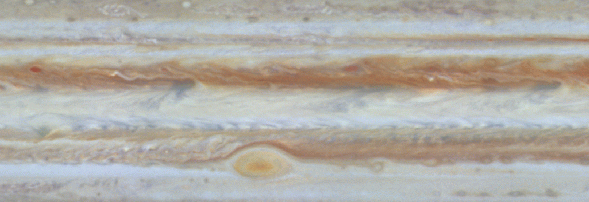Belt-zone circulation on Jupiter
Heat deep in Jupiter's atmosphere convects (churns) gas from
the interior to the surface and back down again. As the gas reaches
the upper layers of the atmosphere, it splits, half falling towards
the equator, half falling to the pole-side. Because of the fast
rotation (300 miles/hr), coriolis force deflects the polar-side
gases east and the
equator-side gas west, in opposite directions (and opposite directions
in the southern hemisphere). Regions of up-welling hot gas are
light colored and called zones. Dense cold, falling
gas is dark colored and called belts. (recall, we saw
this on Earth).
Composition of Jupiter's Atmosphere
He, H, methane, ammonia, ethane and water as well as
ammonia ice, water ice and ammonia hydrosulfide. The
differences in composition, as well as temperature
and altitude make up the varying colors seen in the clouds
of Jupiter.

Jupiter's Rings
Jupiter's intricate, swirling ring system is formed by dust
kicked up as interplanetary meteoroids smash into the giant
planet's four, small inner moons. Jupiter has two main ring
systems, a flattened main ring and an inner, cloud-like ring,
called the halo, both composed of small, dark particles.
Because of Jupiter's great size and mass, objects getting
too close Jupiter can be torn apart if they are within the
Roche Limit. Small particles found in planetary rings
will not be torn up further and may be remnants of larger moons
which wondered within the Roche Limit. It is always within
the Roche Limit that ring systems of the gaseous planets
are found.
 Jupiter is most famous for its colorful swirling clouds, the most
notable feature among this ever-changing turbulence is the Great
Red Spot (GRS), a huge storm system that could swallow up three Earths
and is known to have existed for at least three centuries. Jupiter has
high winds and a large number of these very large, long-lived storm
systems. Unlike low-pressure hurricanes on Earth, the GRS
rotates counter clockwise in the southern hemisphere,
meaning it is a high-pressure system.
Jupiter is most famous for its colorful swirling clouds, the most
notable feature among this ever-changing turbulence is the Great
Red Spot (GRS), a huge storm system that could swallow up three Earths
and is known to have existed for at least three centuries. Jupiter has
high winds and a large number of these very large, long-lived storm
systems. Unlike low-pressure hurricanes on Earth, the GRS
rotates counter clockwise in the southern hemisphere,
meaning it is a high-pressure system.

